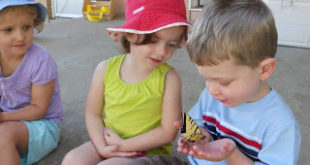Focus on Routines, Not Lesson Plans
Though we are ruled by the clock and the calendar like the rest of the world, we make room for real freedom with a regular routine.
One of the features of a Montessori classroom is the consistency of an established schedule, which promotes what Montessori called normalization. The normalization of children depends to a large extent on their security of knowing what to expect. When children know the plan, they feel secure and are subsequently free to concentrate. If we provide these predictable patterns for the children, they become more self-confident and inner-directed, leading to normalization.
Many Children, Many Schedules
Today’s schools offer programs to suit the busy modern family, making a very long school day for some children. Multiple adults and environments are often part of the child’s day. Children may be going from before-school care, to the classroom, to lunch, then naptime, then more school time, followed by after-school care. Outdoor or playground time must also be worked into this elaborate schedule. The challenge is to get the children from one activity or environment to another with the least amount of disruption.
Establishing the Routine — Sticking with It
Every school develops and establishes transition routines, taking into account staff availability, physical environment, and safety issues. Within the classroom, individual teachers have flexibility in determining how to handle transitions. While each child and classroom is unique, many of the teachers we work with have shared the following ideas for easing transition times:
Starting the day
- Some schools have an assistant who greets children at their cars and accompanies them to their classrooms, while others have parents bring children inside. At the beginning of the school year, the process should include ways to reassure parents about separation issues.
- To ease the transition once children enter the classroom, most teachers greet each child individually by shaking hands and making eye contact; others have a group welcome ritual before the work time begins.
Moving from work time to group time
- Some teachers signal the end of work time by ringing a bell, singing quietly, or dimming the lights.
- After the signal, the children then complete their work, put it away, or protect it for later completion, ready to move to group, lunch, or another activity.
- Think about ways to address the reluctant child. Determine what the parameters will be for someone who chooses to stay outside the group. For example, if a child is quiet, he might watch from a distance.
From inside to outside and vice-versa
- In some schools, children can move freely from the indoor to outdoor classrooms or the playground when it is supervised.
- If the whole class is going outside, children might be assigned to go in pairs to gather their coats, then either rejoin the group or make a line to go outside.
- Some teachers have bells to signal the end of outside time. Some have a process for removing sand and dirt from shoes before re-entering the classroom.
Dismissal
- Cleaning up at the end of the day is a group activity in some classrooms, making sure all materials are back where they belong.
- Children going to after-school care are sometimes accompanied by staff to the other location while the other children wait for their parents.
- Some schools dismiss from outside, others from the hallway or just outside the classroom. Almost all require parents or caregivers to sign the child in and out.
Some teachers say goodbye to each child individually when parents arrive for pick-up. Others may greet parents and talk with the child and parents about the day.
Predictable Routines
The schedule remains important throughout the school day. When children are reluctant or disorganized, this might be a signal that the routine is not working to meet their needs and should be rethought. The children’s developing maturity may call for a different plan. Nevertheless, a consistent structure provides freedom not only for the children who learn to function independently in the classroom, but also for the teacher who can now focus on the progress of individual children as they interact with the prepared environment.
 Montessori blog Montessori blog
Montessori blog Montessori blog 
